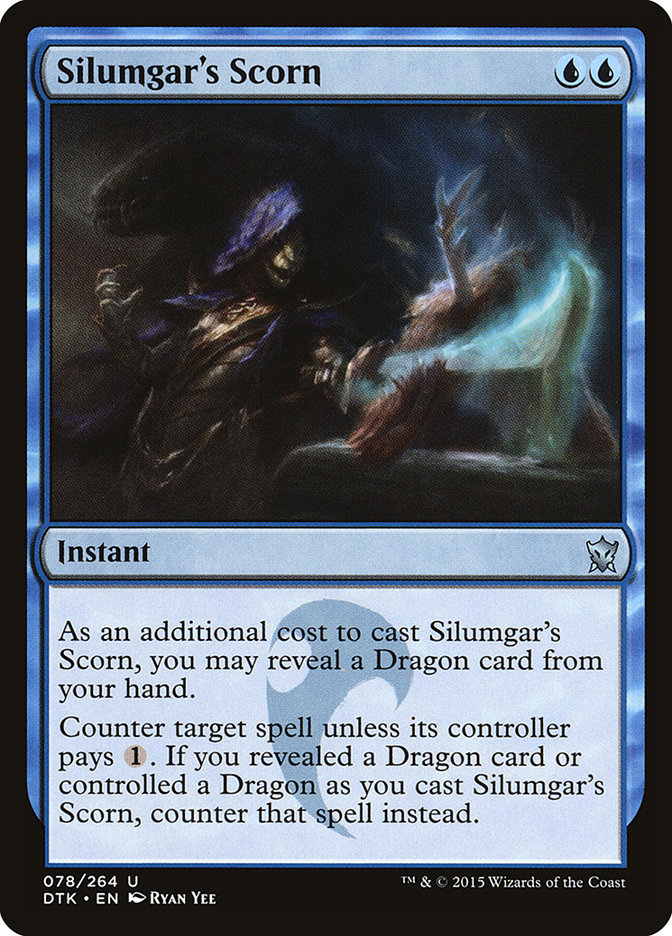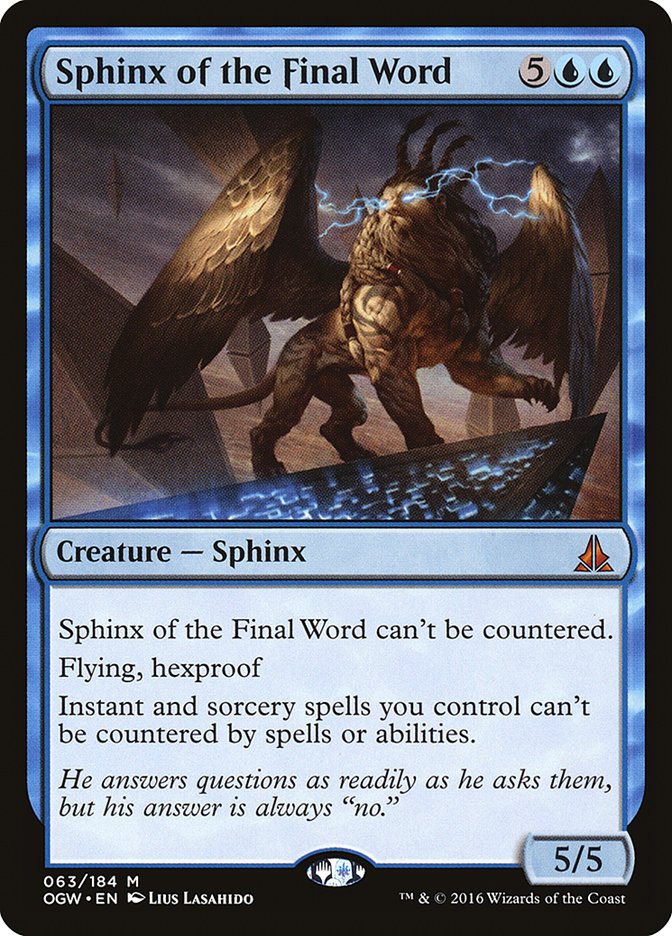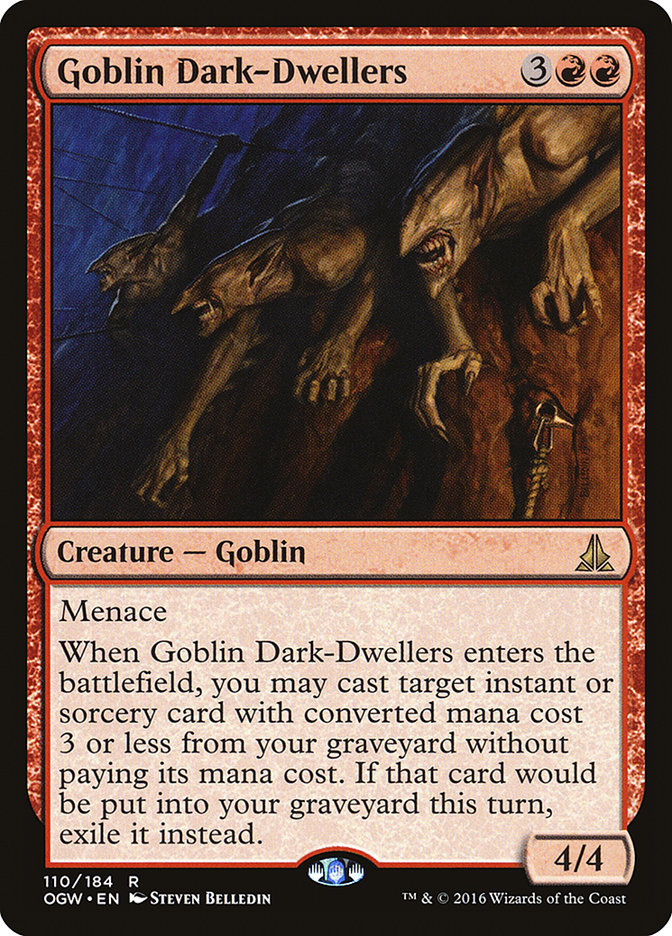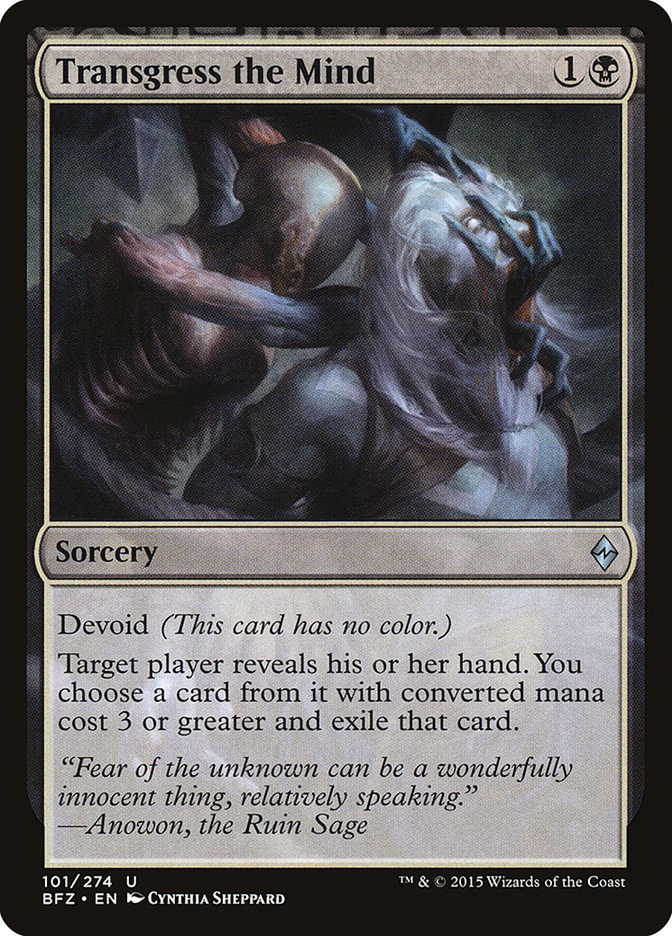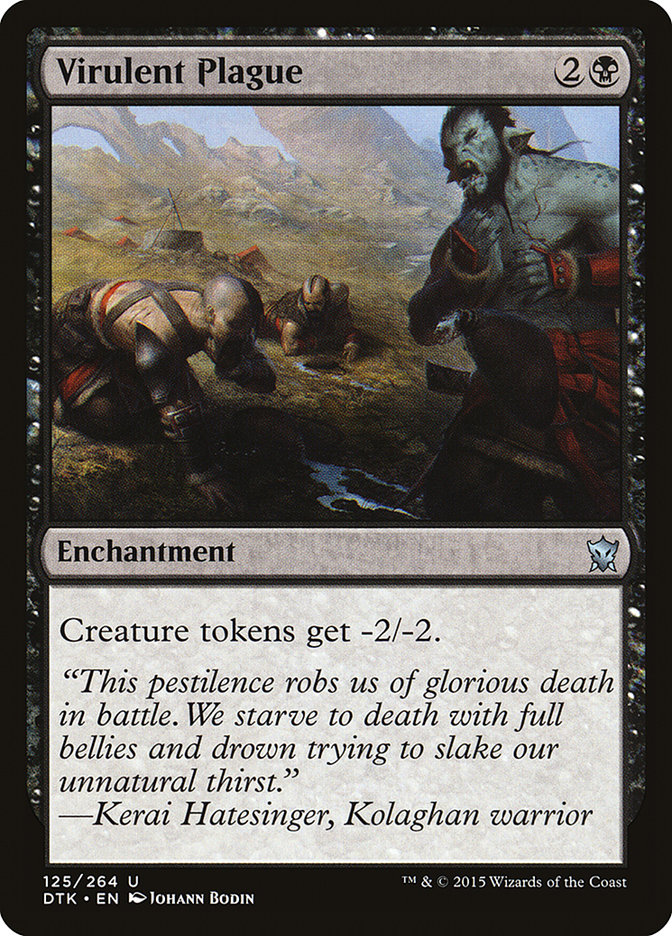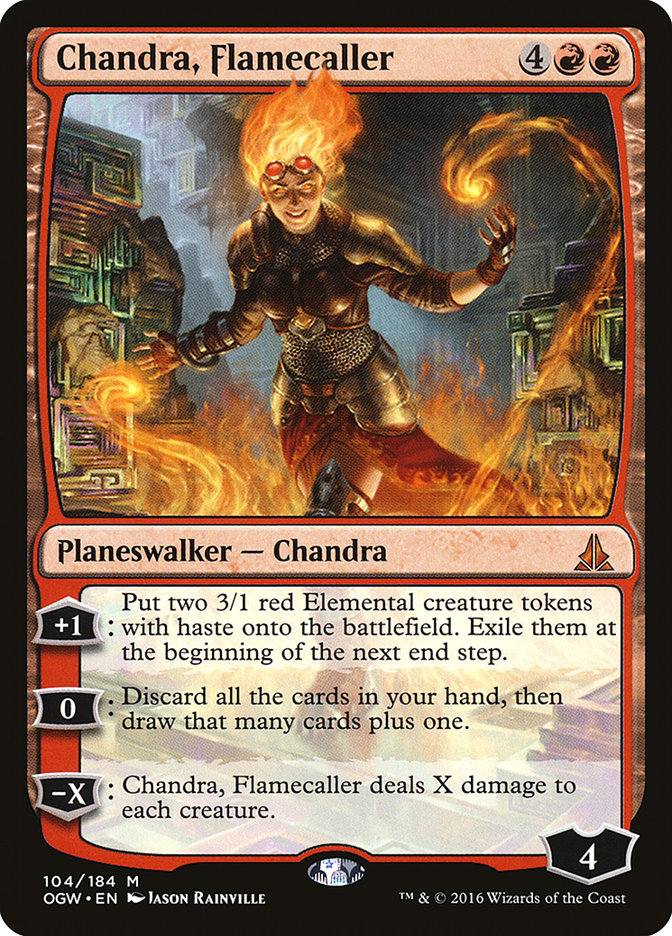Standard hasn’t been this diverse in many years, my friends. We all witnessed eight different decks featured in the playoff rounds at Pro Tour Shadows over Innistrad, with nearly all types of strategies covered. We had the aggressive G/W Tokens and B/G Aristocrats decks, two beautiful Esper Control builds and a wacky B/G Seasons Past control creation, the very definition of midrange in Bant Company, and arguably a “combo”-style R/G Ramp deck piloted by our very own Brad Nelson. This is what true diversity looks like and I haven’t been this excited to be a part of the action since the preview card Sphinx’s Revelation was spoiled.
Grand Prix in Toronto just concluded as well, scoring a win in the Esper Dragons column to go along with its strong Pro Tour finish. Cedric Phillips wrote an article last week that pointed out the weakness in Esper Dragons and accredited the high finish in the Pro Tour to the skill of Shota Yasooka.
Creatures (10)
Planeswalkers (1)
Lands (27)
Spells (22)

I couldn’t have agreed more, which is why I also joined in on the Esper Dragons bashing last week. Even with that Pro Tour finish and Grand Prix win, I still think it’s not the best control option for us to pick up and charge into battle with. My concerns with the weakness of Silumgar’s Scorn are still valid from my end of testing and that is seconded by the majority of the pro community.
When the stars align perfectly, Esper Dragons has the power level to win against any foe; however, in my vast experience with the deck, I don’t think it has the consistency required to beat the field. You all know that, if the Dragon strategy were as solid as the finishes suggest, I would sell the rest of my Standard staples and foil it out today. I would feel guilty telling all of you to sleeve up this GP Toronto champion’s deck and start counting the winnings.
Do I think Esper Dragons can be good? Yes. The biggest issues I had with the deck are laid out in my last article and I highly suggest reading Cedric’s more comical rendition of the problems with Esper Dragons as well.
Here is the non-Dragon list I piloted at Grand Prix Toronto:
Creatures (5)
Planeswalkers (4)
Lands (27)
Spells (24)

I had a disastrous weekend with this Esper Control list and it wasn’t due to losing. I finished Day 1 with a record of 7-1-1, which isn’t too bad. The draw came from a long, hard-fought Game 3 where I ended the fifth turn with all of my planeswalkers out, but not enough time to seal the deal.
My opponent was awesome and a pleasure to play against; however, he wasn’t interested in determining who’s going to easily win based on the battlefield state and choosing a winner. I have never been the type of player to pressure an opponent to concede if the game has a clear outcome in a turn or two, so I smiled, shook his hand, and wished him the best of luck.
There was a crowd that amassed around the match and some were shocked at the way I handled it, which I find to be surprising. That leads to the conclusion that some players get hostile when the draw is looming and concessions don’t kick in. I think it’s a fascinating debate one way or the other, but I’ll leave that topic for another day.
Day 2 begins and I find myself playing other decks that take some time to pilot and win with. To make a long story short, I ran into the draw scenario two more times out of the final four rounds I played, which forced me to hit the lab immediately after. I receive fewer unintentional draws than almost every player out there that isn’t a regular red zone user. I’ve also taken great pride on my ability to play quickly and make sure my opponents are not milking the clock as well. My opponents this weekend were not slow-playing. The Esper deck just doesn’t win quickly enough.
I had my copy of Sphinx of the Final Word to get pressure as early as a planeswalker deck can, but it didn’t play a big enough role for the mana invested. When I’m playing online, the amount of time it takes to seal the deal is skewed. The program shuffles, searches, and performs most in-game acts more quickly than any person can do. MTGO is the greatest tool for a mage to test any set of cards; however, the time clock is a blessing and a curse for those of us preparing for real-life gameplay.
I had six wins easily at the Grand Prix before time became a punishing factor, but many of those wins were sweeps and would have been an issue if a Game 3 ensued. My mind was racing after I dropped from the tournament, trying to figure out some way to speed the deck up without reverting back to an archetype of Esper that I felt was inherently weak in the field, but the options weren’t pretty. There was From Under the Floorboards, or maybe just a few creatures would work.
Kalitas, Traitor of Ghet was absolutely amazing, so that could be an easy inclusion to make the deck faster. I then turned to Plan C from one of my earliest brew articles with the new set in mind, which happened to be on the road to a Top 8. I whipped out the proxies on site and began to create Grixis Control based on some suggestions both Noah Walker and Oliver Tiu gave when I approached them with the idea. Their lists were pretty tight; however, I found a few cards a bit suspect when comparing them with my drafted version. Here is the list I came up with and have been testing ever since:
Creatures (11)
Planeswalkers (2)
Lands (26)
Spells (21)

The list that Oliver made Top 8 with was on the right track in the majority of areas. Goblin Dark-Dwellers is the most powerful creature a control deck can use and that is what this strategy is based on.
The card that everyone is frantically trying to obtain, though, is Kalitas, Traitor of Ghet, the best option we have in the fight against green decks. It removes problematic creatures from the battlefield, denies them graveyard existence or triggered abilities, gains life, creates an army, can become huge at will, and has a decent size for the mana cost. I knew Kalitas, Traitor of Ghet was good, but wasn’t aware how powerful it is even with sweepers.
The obvious card that has synergy with this powerhouse is Radiant Flames, which is a must in the sideboard of any red control deck. I did a few things to the deck to fix the holes that were discovered by theory and testing.
Having no answer to Westvale Abbey is an absolute nightmare and had to be corrected immediately. I began by putting in one copy of Silumgar’s Command, but that was not even close to enough to give the best chance against arguably the most powerful card in the format. It hurt my head trying to think of alternative answers to the flying nightmare created by the land, but there isn’t much else short of draft commons.
I then put together the Dark Petition package in my Grixis Control build and the results were stunning. I now had three answers to indestructible creatures, five copies of Goblin Dark-Dwellers, four copies of Chandra, Flamecaller…the list goes on. Control thrives on diverse threats and answers, which is the reason why I’ve been playing Dark Petition for months. Adding this card allowed me to cut down on the capped numbers of Goblin Dark-Dwellers and Kalitas, Traitor of Ghet, which helped keep the curve similar. Dark Petition is also a killer for any opponent to face down when Jace, Vryn’s Prodigy is involved.
The manabase that Oliver and Noah came up with needed some tender loving care after playing the initial games with it. Shivan Reef is super-mediocre as a mana fixer and taking damage regularly to cast spells is terribly taxing when it doesn’t have to be. I switched out a few of those, corrected the Battle lands count to eight, and corrected the basics to reflect the demand for Jace, Vryn’s Prodigy mana on turn 2.
These changes had the deck move from simple operation to firing on all cylinders. There are some differences in the number of removal spells, but that is because I like to live dangerously. My version of the deck has five removal spells that cost one or two before you hit the jackpot from turn 3 on. Between five super-cheap removal spells, Transgress the Mind, and Jace, Vryn’s Prodigy, it’s enough to guarantee a play in the early-game.
The curve of my version shifts forward some but gives this deck strong game against G/R Ramp Game 1 (with a maindeck Infinite Obliteration) and against Westvale Abbey.
The part of this deck that I was most impressed with was the sideboard. The cards in the sideboard fill the matchup gaps that the deck had except for G/R Ramp. I play against that deck at least twice a tournament, so not having any assistance in the sideboard is a bit ambitious.
I fixed that problem by adding additional disruption and some counterspells. Four Duress is a bit excessive in the deck because there are some matchups that demand just a few. The Negates serve a similar purpose and are much more effective later in the game. Having no counterspells also feels a bit wrong to me and makes the control player too linear. Having answers at instant speed for any big spell finisher is important, and Negate is the best we have.
I added a Virulent Plague and it improved my G/W Tokens matchup ten percent. The card is necessary regardless of how non-synergistic it is with the rest of the spells in the deck.
I know its issue with Chandra, Flamecaller and Kalitas, Traitor of Ghet; however, that is a sacrifice that must be made to keep tokens off the battlefield. Kozilek’s Return is the next-best option, which is a much weaker alternative to a permanent ability.
Dragonlord Silumgar is the only hope against threats too high and mighty for the conditional removal to deal with. Sometimes you just have to steal their creatures and there is no one better at it than our Dragon friend. The two in the maindeck I found a bit cumbersome and there are quite a few matchups where a six-mana Dragon just isn’t an option.
Dragonlord Silumgar is joined by Jeskai Black all-star Dragonmaster Outcast. This card has really impressed me and is brought in against a variety of decks. With the power of Kolaghan’s Command, this little creature can transform from a nuisance to the best win condition control could ever dream of. There are many occasions where I used Dark Petition on turn 6 with a red mana available to bring it straight onto the battlefield and proceeded to destroy my opponent with an army of Dragons.
I don’t think two is the right number of cards like these, especially with Dark Petition and ways to bring it back, so I dropped the number to one and it’s been fantastic. The only bad card in the entire 75 is Fevered Visions. Fevered Visions isn’t a card I’d bring in against any opponent, so leave these in the bulk rare section of your binder unless you’re in that U/R Goggles kind of mood.
I don’t think that this deck is superior to Esper Control in terms of power level and consistency. If there were 55-minute rounds, then I’d probably continue to work with the Esper shard and keep battling with the colors I’m most known for, but that’s not happening.
This deck has the power to finish games quickly with bigger-creature lands, a vicious planeswalker, and a creature package that other control decks can’t use. Goblin Dark-Dwellers has menace for some reason and is the perfect size to take down any creatures that gang up on it with a little help from the Grixis Control removal package.
I have been on a tear with this deck online and I hope that translates to success on the SCG Tour® this year. I was delighted to hear that the tour is heading to Richmond, which is nearly right up the street from me. I’ll be there, Baltimore, Columbus, and most definitely at the New Jersey Invitational. I hope that you all have success in the upcoming SCG Tour® tournaments, and if you’re at one of these events I mentioned, introduce yourself and let’s talk control!



